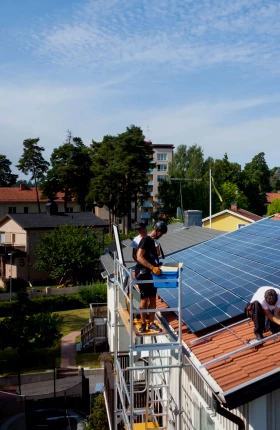Stefan Gross-Selbeck , the global leader of climate technology at BCG, talks about the technologies that will help us reach net zero.
Meet Stefan
BCG: Why are ecosystems necessary in the development of green technologies? What is missing in traditional R&D and innovation activities that ecosystems can solve?
Stefan Gross-Selbeck: The very short answer is speed. To get to net zero in time, we need to bring multiple new technologies to scale. The technologies that are or soon will be cost competitive cover only around 55% of global emissions. That’s why ecosystems are so critical. We must move at warp speed, faster than any technology has ever been taken to this level of maturity.
The only way to do this is for players across the value chain to work together. In that way, they can solve problems that arise quickly. And that’s what we mean when we say we need ecosystems to get us to net zero.
But ecosystems are hard because you must build trust. You must move from a transactional relationship to a trust-based, longer-term relationship, and that’s not easy. You need to invest in relationships. You must negotiate with many stakeholders. In other words, ecosystem participants must go slow at the beginning of these relationships to eventually go fast.
Is it similar to moving from a waterfall approach to more of a parallel-processing approach?
The terminology you’re using comes from software development, where we talk about waterfall versus agile development. It’s actually very similar. We want to move from a sequential process to an iterative process. And to do that, we need different players to work very closely with one another—ideally, physically close to each other—which is why hubs are so important.
What city or region could develop into a sort of Silicon Valley for climate technology, with a strong mix of talent, capital, and dealmakers?
Many of the technologies we need to get to net zero are leveraging very traditional industrial processes, such as steel or cement production. You’ll find many of the new green technologies are therefore created close to more traditional industrial sites. For example, in Germany, you have these very strong, very traditional industrial locations where startups are located, such as North Rhine–Westphalia.
There are lots of software solutions, too, so you are seeing activity in the traditional innovation hubs, including Silicon Valley, and other locations in Europe and Asia.
Does reaching net zero depend on the development of moonshot technologies, or are there technologies we need on the near horizon?
We pretty much know already which technologies we need to get to net zero: low-carbon hydrogen, bioenergy, carbon removal, carbon storage, and so forth. These are technologies that we already have, that we already understand, but that are not at scale. It’s not about coming up with something crazy.
Historically, most investments in climate sustainability have been concentrated in mature, well-understood technologies, such as power generation. What must change to encourage greater investment in emerging technologies?
We need much tighter partnerships between the public and private sectors. We’ve had recent examples of these arrangements, including the Inflation Reduction Act in the US and the European Green Deal, where governments provide frameworks and incentives for the private sector to invest. We need an environment that makes it attractive to private investors to take significant risks as we scale these technologies.
There are also things the private sector has done and can do—for example, providing offtake agreements where industries or industry players come together and commit to buying certain quantities of products that have not yet been produced. That’s very powerful because it removes the commercial risk of a particular venture.
Isn’t the risk with industrial policy that governments will bet on the wrong technologies?
In the digital technology space, that’s true. Ten or fifteen years ago, nobody knew for sure what technology was going to be impactful. The situation is different in green technology. We know we need a hydrogen-based economy. Full stop. I think governments are in a much better position to make smart decisions supporting these kinds of investments. The private sector alone will not solve it. Neither will the public sector. It really takes both.
What is the most misunderstood deep climate technology?
There is a debate about carbon capture technology. Some people are concerned that it provides an opportunity for greenwashing. They believe carbon capture may cause people to conclude that they can lessen their mitigation efforts. I think that’s wrong. We need carbon capture technology as well as mitigation capabilities. We absolutely need to reduce our consumption of fossil fuels, but we also need technologies to capture the remaining emissions. I think that’s a technology that has a bad reputation, but it’s super valuable. We need it, and we need to invest in it.
How can businesses influence consumer behavior?
Influencing consumer behavior is going to be critically important. We need initiatives from the supply side. That’s mostly done by industries, sometimes in partnership with governments. But we also need to work on the demand side by making it worthwhile for consumers to pay a green premium, which will continue to be required in several categories. We need to do a better job of positioning these products and explaining their benefits.
What is the role of business model innovation in the climate technology field?
In the digital space, software as a service or direct to consumer were completely new models. There are areas, such as the circular economy, where new models are very important. But for the most part we need new ways of doing established things differently, such as positioning, explaining, and packaging products to show the value they create for net zero.
If you look at green steel, for example, that’s a product and process innovation. But at the end of the day, it is still steel, just without the emissions. So, it’s not really about business model innovation, which typically requires innovation across the entire value chain.
AI—and generative AI—is a hot topic both within and beyond the climate space. What’s its potential impact?
Obviously, AI allows us to better model and understand climate itself, how it evolves, how we forecast it, and how we understand and assess the impact. It allows us to do this very specifically in certain parts of the planet.
We’re seeing AI developments in satellites to track CO2 storage and to generate nature-based and agricultural solutions. Armed with greater information, we can start building transformation pathways and subsidy schemes to help farmers adopt more sustainable practices. That’s just one example.





